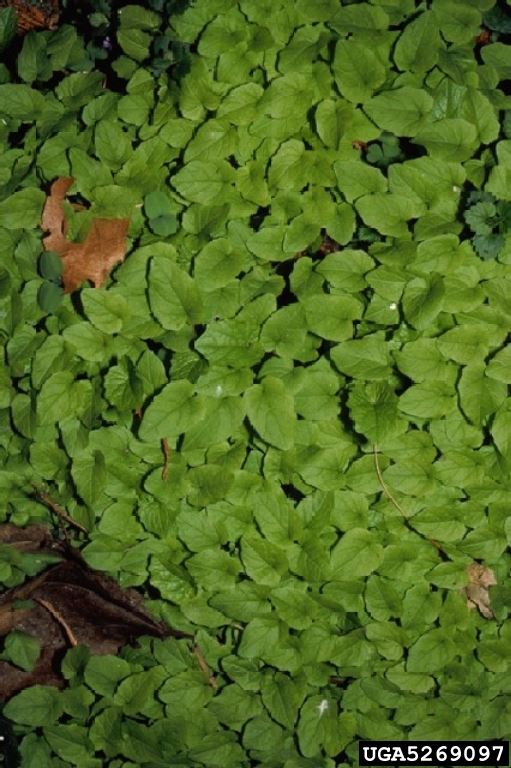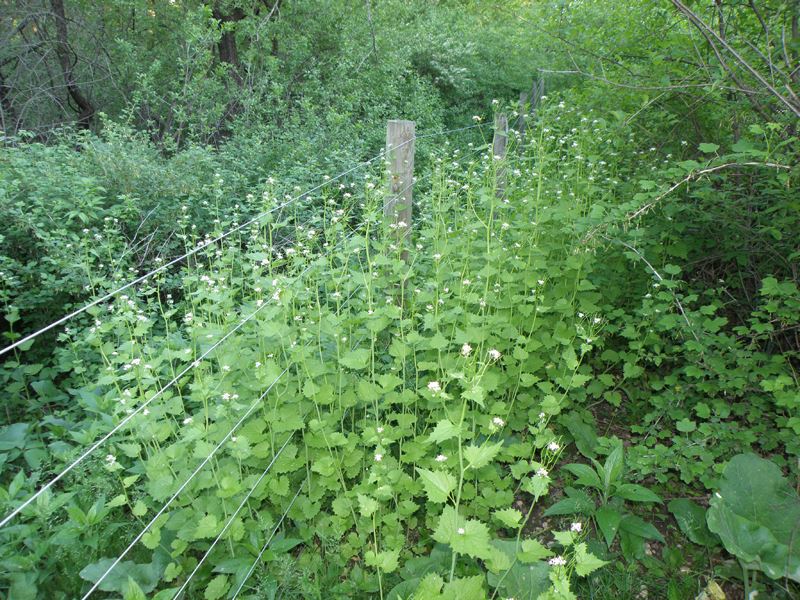by Paul Erdmann, Conservation Director
Most people are familiar with buckthorn, a non-native invasive plant that has taken over many acres of land in Bloomington and beyond. Another invasive plant to be wary of is garlic mustard, Alliaria petiolata. This invader arrived with European settlers in the 1800s, likely for food and medicinal purposes. It is an early season biennial herb that thrives in many conditions, including woodlands, floodplains, and people’s yards. It spreads by seeds which are disbursed by ripe seed pods that can propel seeds several feet away, and by water, animals, and people. Because of its aggressive nature and prolific seeding, and lack of parasites and diseases, it alters ecosystems and chokes out beneficial native plants that pollinators and other wildlife depend on. Garlic mustard exudes chemicals into the soil that suppress native plants. Deer and other animals do not eat this plant. It is edible for people, and you can find pesto and other recipes online. When the leaves are crushed it emits a strong garlic smell. Garlic mustard often moves in after buckthorn removal or other disturbances, so monitoring for this plant and stopping its spread is critical.
land in Bloomington and beyond. Another invasive plant to be wary of is garlic mustard, Alliaria petiolata. This invader arrived with European settlers in the 1800s, likely for food and medicinal purposes. It is an early season biennial herb that thrives in many conditions, including woodlands, floodplains, and people’s yards. It spreads by seeds which are disbursed by ripe seed pods that can propel seeds several feet away, and by water, animals, and people. Because of its aggressive nature and prolific seeding, and lack of parasites and diseases, it alters ecosystems and chokes out beneficial native plants that pollinators and other wildlife depend on. Garlic mustard exudes chemicals into the soil that suppress native plants. Deer and other animals do not eat this plant. It is edible for people, and you can find pesto and other recipes online. When the leaves are crushed it emits a strong garlic smell. Garlic mustard often moves in after buckthorn removal or other disturbances, so monitoring for this plant and stopping its spread is critical.
The good news is that garlic mustard is more easily managed than buckthorn, especially if caught early, which is important as one plant can become hundreds in just a few years. In the Spring, before seed set, adult plants pull easily, especially when soil is moist. Be sure to pull the entire tap root, or it can re-sprout. Plants that are pulled and left on the ground may still flower and set seed. Flowering plants or plants with seed pods should be removed from the site and properly disposed of to prevent seeding. Since it is a biennial (plants flower under the right conditions, set seed, and die- usually a 2-year life cycle) preventing it from seeding is critical. Seeds may remain viable in the soil for 5 to 10 years. In addition to hand pulling, cutting, herbicide, spot burning, and prescribed fires are used to manage garlic mustard. Many animals, pollinators, and native plants such as wild geranium, Jack-in-the-pulpit, columbine, and wild ginger will be grateful for your efforts! Garlic mustard is a Restricted Noxious Weed in Minnesota, which means it is illegal to intentionally grow it or sell it, and landowners are strongly encouraged to manage it on their properties in order prevent its spread.
For more info, go to:
Controlling Garlic Mustard Video by the City of Bloomington
https://www.mda.state.mn.us/plants/pestmanagement/weedcontrol/noxiouslist/garlicmustard
https://hort.extension.wisc.edu/articles/invasive-plants-of-wisconsin-garlic-mustard/
Photos by Minnesota Department of Agriculture (top- flowers and seed pods, and bottom- infestation) and Leslie J. Mehrhoff, University of Connecticut, Bugwood.org (middle- first year seedlings)
